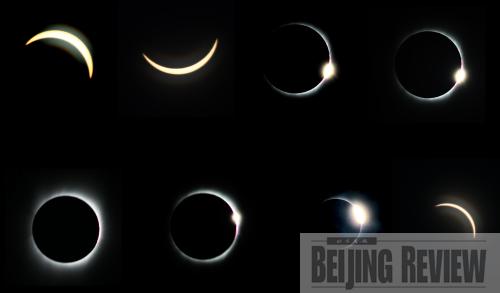|
 |
|
AMATEUR OBSERVERS: Chongqing Municipality residents use welder's masks to watch the total solar eclipse, which lasted more than 6 minutes on July 22 (ZHOU HENGYI) |
Holding a big colored umbrella and wearing special glasses, Chen Diefeng, a Shanghai shipping company employee, celebrated July 22's total solar eclipse with his girlfriend.
"Though it rained, we didn't want to screw up the mood. We enjoyed this special day," he said, adding that they would not be able to wait around for the next event like this, some 300 years from now.
The eclipse, caused when the moon moves directly between the sun and the Earth and casts a shadow on the planet, lasted 6 minutes and 43 seconds. During a total solar eclipse, the sun, the moon and the Earth are directly aligned and the moon completely blocks the light coming from the star from the vantage point of observers on Earth. July 22's event was the longest total solar eclipse Chinese people will see for a long time.
Eleven provinces in China's southwestern, central, southern and eastern areas, such as Tibet Autonomous Region, Hunan and Jiangsu provinces, were supposed to be able to witness the eclipse. But rain and clouds in many Chinese cities along the eclipse shadow's path along the Yangtze River prevented some from seeing it.
According to Wang Sichao, an expert with the Purple Mountain Observatory of the Chinese Academy of Sciences (CAS), which is based in east China's Nanjing City, Jiangsu Province, the number of people watching the solar eclipse made history, since previous solar eclipses could only be observed in desolate regions.
The rare astronomical spectacle spurred tourism in some cities where good observations could be made.
In Jiaxing, Zhejiang Province, every hotel and inn was fully booked by eclipse watchers, 6,000 of whom traveled from outside China, said Zhou Hongxia, Deputy Director of the local tourism administration. She mentioned that many of the watchers started to book rooms more than a year ago.
Nearly 3,000 astronomy enthusiasts from Japan, the United States and Europe had also flocked to the central province of Hubei, according to the provincial tourism administration. About 500 visitors rented a local college's football pitch to get a better view of the eclipse.
 |
|
SUN TRICK: The pictures show different phases of the rare total solar eclipse taking place on July 22, in Jiujiang, Jiangxi Province (CFP) |
Before the big event, Chinese scientists set up 17 observation stations along the central line of the solar eclipse that ran through China to capture a sequence of images of the sun's corona in a bid to understand its outer atmosphere. The stations were scattered along the eclipse's path from Yunnan Province to coastal Zhejiang Province. The eclipse traversed 2,500 km across China
"The corona is the sun's outermost atmosphere, which is relatively dim, and can only be observed through a specialized coronagraph on a normal day," said Ji Haisheng, a research fellow with the CAS Purple Mountain Observatory. A coronagraph is an instrument designed to block light from the main solar surface in order to observe the corona alone.
Scientists have previously observed that solar winds erupting across the surface of the sun result in coronal mass ejections, or eruptions of material from the star. Communications and electric grids on the Earth can be disturbed.
The corona is separated from the sun's photosphere by a relatively shallow chromosphere. But scientists still haven't found the exact mechanism by which the corona is heated. The studies on chromspheric lines and polarized radiation have helped give clues to the magnetism of the solar atmosphere.
"The corona could have a tremendous influence on the Earth, but it remains a puzzle. It has become an interesting research focus for astronomers around the world," Ji said.
Some of the recorded images of the corona were "not so perfect" due to clouds, and the data is being analyzed now, said Zhang Hong, a leading researcher with the National Astronomical Observatory.
The last total solar eclipse visible in China took place on August 1, 2008. It lasted two minutes and was observed in Yiwu County, in the northwestern Xinjiang Uygur Autonomous Region. | 